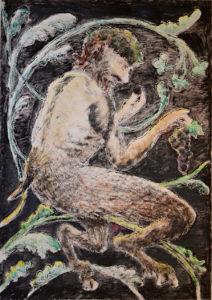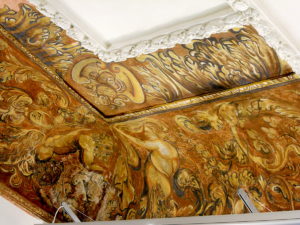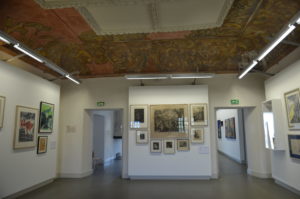 Satyr (No. 3)
Satyr (No. 3)
Véronique Champollion
2021
Collagraphy on Velin d’Arches paper
170 cm x 100 cm
Edition of 5 (all unique pieces)
Véronique Champollion’s collagraphy shows a laterally squatting satyr. Acanthus tendrils surround him. In his right hand, the mythological figure holds a bunch of grapes, in his right leading to the mouth a single one. The print is inspired by a fresco in the Chateau of Carros in the south of France. However, the artist broadly interprets the original from the 17th century. In contrast to the almost monochrome painting, Véronique’s version is coloured on black background. She added also the grapes and arranged the acanthus leaves as tendrils.
 A satyr is a figure of the Greek mythology, which found its way into the visual already in antiquity and came through us in many epochs until today. As companion of the Greek deity Dionysus, satyrs are characterised as lovers of wine, music, dancing and women. The hybrid being is described as a little bit naïve person with a cheerful spirit or even ribald and obscene. Véronique’s satyr seems to tend to the amusing version, since he has a friendly face, in joyful anticipation to nibble the grape. This fruit refers to his deity, the god of the grape-harvest, winemaking and wine, who became in roman times Bacchus. In his company, the satyr was a life enjoying bacchant.
A satyr is a figure of the Greek mythology, which found its way into the visual already in antiquity and came through us in many epochs until today. As companion of the Greek deity Dionysus, satyrs are characterised as lovers of wine, music, dancing and women. The hybrid being is described as a little bit naïve person with a cheerful spirit or even ribald and obscene. Véronique’s satyr seems to tend to the amusing version, since he has a friendly face, in joyful anticipation to nibble the grape. This fruit refers to his deity, the god of the grape-harvest, winemaking and wine, who became in roman times Bacchus. In his company, the satyr was a life enjoying bacchant.
Like the satyrs, we know the acanthus from the Greek antiquity. As symbol of immortality, it was planted besides grave steles. In sculpture, the thistle-like vegetable found its way into ornamental decorations, in particular as leaves forming Corinthian capitals. Much later, in baroque times it became a tendril, formed by concatenated single leaves, since in nature the acanthus plant has no tendrils. By the time, the foliage developed to by lines connected elements, sometimes garnished with flowers. Véronique borrowed this ornamental depicting, following the expressive forms of her inspiring fresco.
 Moreover, the ceilings of the chateau in Carros are a special example of a “rustic” 17th century decoration. Notably the acanthus motives are exuberant and fanciful. In contrast, the figures are unusually roughly painted. They almost fade among the dominant vegetal adornments. In her interpretation, the artist reversed the relation in favour of the satyr.
Moreover, the ceilings of the chateau in Carros are a special example of a “rustic” 17th century decoration. Notably the acanthus motives are exuberant and fanciful. In contrast, the figures are unusually roughly painted. They almost fade among the dominant vegetal adornments. In her interpretation, the artist reversed the relation in favour of the satyr.
Whereas, the graphic print is not so typical in Véronique’s more sculptural oeuvre, the approach is similar. The artist isolates characters of historic artworks and interprets them, often with a humoristic wink. Correspondingly, she picked the satyr from the fresco and set him in a modified context. In contrast to the inspiring source, the mythological character is depicted almost mischievous and not as grimly as in the original. The surrounding acanthus is formed like a protection, remembering a clump of bushes. Here, the satyr is shielded from the view of others and can eat his grapes in tranquility, if we were not watching him.
Véronique Champollion
Born in Valence, France (1957) Véronique went to the Ecole Nationale Supérieure des Arts Décoratifs (ENSAD) and also achieved a DEA (MA) in Modern Indian Studies on Hindi films. She has been part of diverse groups of artist self-organisations like ART MOBIL with its journal and No-made, both in the region of Nice. Furthermore, she is member of the Association Internationale des Arts Plastiques (AIAP)-Unesco, based in Monaco.
Besides painting, the artist forms reliefs and sculptures from newspapers and posters, combined with glue, fiberglass and resin. With a glance to art history, legend and fairy tales, Véronique interprets her sources astute and humorous. Favourite inspirations she takes from classical paintings for example by Botticelli or Velasquez. Her sculpture “Botticelli’s Spring” is our artwork of the month of May 2015.
During her long artistic practice, she created several Madonnas in her different techniques. There are archaic ones like a Madonna of Snow, a monumental outdoor sculpture. Others are more classical works like the Madonna with Child, our artwork of the month December 2017. In addition, these Madonnas might have contemporary references. Often the Madonnas are inspired by paintings inter alia by Giovanni Bellini.
Even though her sculptures are precious pearls by themselves, she sometimes brings them to life, in placing them into images for visual poetry stories, published as books in France, Italy and Belgium. Moreover, she contributed articles and illustrations to various journals of visual poetry.
Several Galleries in France, Italy, Monaco and the United States represent Veronique’s works. In the same countries, she had numerous personal and group exhibitions, but as well in Belgium, Germany, Switzerland and Hong Kong.
A personal exhibition on fairy tales in January 2015 in Valence included an installation of a newspaper forest. Another in March and April 2015 at the Montpellier University showed many artworks inspired by Occitan literature (Troubadours, Mistral and actual poets). In 2017, Véronique participated in a group exhibition at the Italian Cultural Institute in Paris, where she proposed a visual dialogue between Paris and Milan, with Neapolitan interferences as installation of citations coming from paintings of the three towns.
In September 2020, Véronique participated in a group exhibition about the history of engravings in the Media Library Albert Camus in Antibes. Hence, the inspiration to engage more intensively with graphic prints. Besides many other works, she made a series of prints, in particular collagraphies for her next show. One of these works, “Satyr” is our artwork of the month in March 2021.
www.champo.com/art/v_accueil.htm
